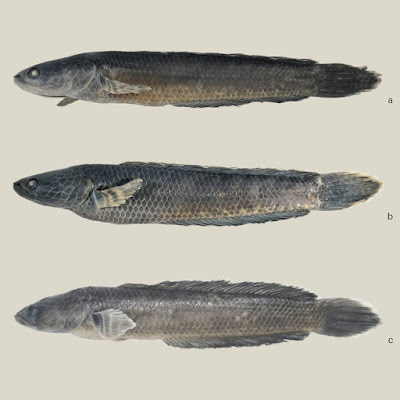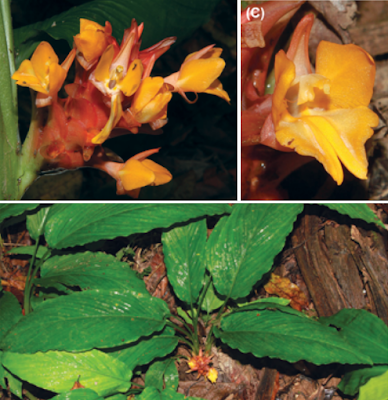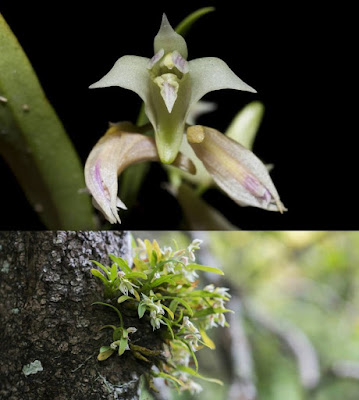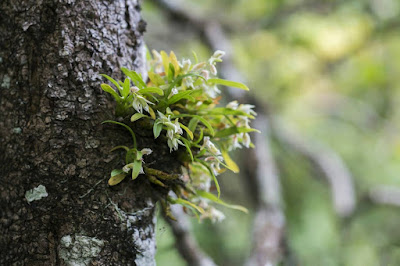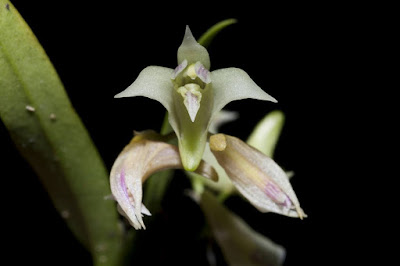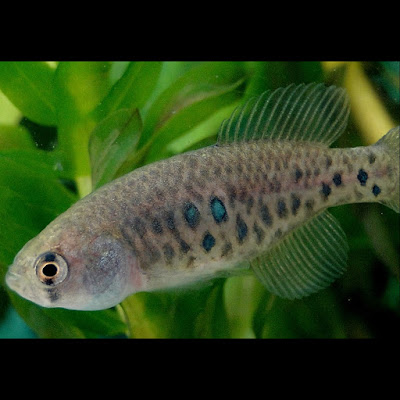[Most Recent Entries] [Calendar View]
Tuesday, October 24th, 2017
| Time | Event | ||||||
| 12:10a | [Ichthyology • 2017] Channa shingon • A New Dwarf Snakehead (Perciformes: Channidae) from western Yunnan
Abstract Channa shingon, new species, is described from small mountainous rivulets associated with the Irrawaddy drainage in western Yunnan Province, China. Its maximum SL of about 100 mm makes it the smallest pelvic-fin bearing dwarf snakehead. Further specific characters are lateral head length 27–30 % SL; interorbital width 33 –35 % HL; 25–27 anal-fin rays; 44–45 lateral-line scales; 4 –5 scale rows between dorsal-fin origin and lateral line; 8 –9 scale rows between lateral line and anal-fin origin; 1 mandibular scale; 43–44 vertebrae; inferomesial process of parasphenoid very shallow and straight; dorsal profile conspicuously bulging in front of dorsal fin; juveniles without ocellus-like mark on posterior part of dorsal fin; and a pectoral-fin pattern of 3 – 4 broad gray to black bands alternating with cream to white interspaces, bands increasingly wide towards distal edge of the fin, interspaces equally wide as bands or narrower. Key words: Channa; new species; Irrawaddy; Salween; taxonomy Channa shingon, new species Diagnosis. Channa shingon is distinguished from other members of the C. gachua-complex (Britz, 2008) by having a lateral head length 27–30 % SL; interorbital width 33 – 35 % HL; 25–27 [26] anal-fin rays; 44– 45 [45] lateral-line scales; 4 –5 [4] transverse scales to dorsal-fin origin and 8–9 [8] to anal-fin origin; 1 mandibular scale, 43 –44 [44] vertebrae; inferomesial process of parasphenoid very shallow and straight; dorsal profile conspicuously bulging in front of dorsal fin; pelvic fin present; juveniles without ocellus-like mark on posterior part of dorsal fin; a pectoral-fin pattern of 3–4 broad gray to black bands alternating with cream to white interspaces, width of bands increasing towards distal edge of the fin, interspaces equally wide as bands or narrower; and a maximum standard length of about 100 mm. Distribution. Known from the Irrawaddy and Salween drainages in Dehong and Lincang prefectures, Yunnan, China; expected to occur in the same drainages in Myanmar. Ecology. Channa shingon prefers weedy, stagnant water sections of small mountainous rivulets. These rivulets are often redirected to irrigate rice paddies. At the type locality, the ankle-deep water was clear, with a pH of 5.9, a conductivity of 20 µS/cm, and a temperature of 12 ºC in the afternoon. The lower reaches of these rivulets, shortly before the influx into a larger stream are usually also inhabited by Misgurnus anguillicaudatus and juveniles of C. harcourtbutleri. Another habitat of C. shingon, the Mengnaihe River upstream of Xima at an elevation of 1730 m, had a water temperature of just 8 ºC in the morning (pH 6.7; 20 µS/cm); some backwaters had a thin layer of ice after a chilly night. Vast areas of C. shingon’s habitats are ephemeral and desiccate during droughts. Etymology. The specific epithet is derived from a character in Burmese spiritualism. Shingon, also referred to as Lady Humpback, is one of the 37 officially recognized spirits (nats) in Myanmar; an allusion to the species’ humpbacked appearance; a noun in apposition. Marco Endruweit. 2017. Description of A New Dwarf Snakehead (Perciformes: Channidae) from western Yunnan. Vertebrate Zoology. 67(2); 173-178. | ||||||
| 12:33a | [Botany • 2017] Curcuma cotuana • A New Species (Zingiberaceae: Zingibereae) from Quảng Nam Province, central Vietnam
Abstract A new ginger species, Curcuma cotuana (subg. Ecomatae), from Tây Giang District, Quảng Nam Province, central Vietnam, is reported here. A detailed description, colour plates, and comparison with the morphologically closest allies are given, together with preliminary conservation assessments and notes on its uses by local people. Curcuma cotuana Luu, Škorničk. & H.Đ.Trần sp. nov. Etymology: We name this species after the local Cơ Tu ethnic minority, who use various parts of the plant in their traditional medicine for its anti-inflammatory properties. Vernacular name and uses: The vernacular name of this species, Pơr’vih in the Cơ Tu language, conveys an idea of keeping the living environment of people in the village peaceful and protected against bad spirits. The main rhizome is stewed with chicken and eaten by women after birth, giving them strength to work soon afterwards. It also reduces menstrual cramp in women. Raw root tubers are mixed with honey to treat coughs in children. Young leaves are mixed with rock salt to treat toothache and gingivitis. Fresh leaves are also used for wrapping fresh fish to preserve it from spoilage. The local people also believe that the plant possesses magic qualities preventing people from getting lost in the forest. Hồng Trường Lu'u, Hữu Đăng Trần, Trần Quốc Trung Nguyễn and Jana Leong-Škorničková. 2017. Curcuma cotuana sp. nov. (Zingiberaceae: Zingibereae) from central Vietnam. Nordic Journal of Botany. 35(5); 552–556. DOI: 10.1111/njb.01594 | ||||||
| 1:03a | [Botany • 2017] Dendrobium chiangdaoense • A New Species (Orchidaceae) from northern Thailand
Abstract Dendrobium chiangdaoense, a new species belonging to Dendrobium section Stachyobium is described and illustrated. It is only known from the type locality in mixed deciduous forest at ca. 800 m elev. on limestone hills in Chiang Dao District, Chiang Mai Province, northern Thailand. It most closely resembles D. dixonianum, a more widespread northern Thailand species occurring in upper montane rain forest at 1,650–1,800 m elev. Keywords: Orchidaceae, Dendrobium sect. Stachyobium, Dendrobium chiangdaoense, new species, Monocots
Dendrobium chiangdaoense Promm., Kidyoo, Buddhawong & Suddee sp. nov. Dendrobium chiangdaoense is most similar to D. dixonianum but differs in having bract longer than pedicel plus ovary, inflorescences not exceeding leaves, lateral sepals obliquely falcate-triangular not recurved, labellum bright green, apex of keel acute and not divided to lobes. Type:—THAILAND. Chiang Mai Province: Chiang Dao District, ..., ca. 800 m elev., October 2015, Buddhawong & Suddee 018 (holotype BKF!). Distribution.—Northern Thailand (Chiang Mai Province). Habitat & Ecology.—Epiphytic herb on tree trunks in mixed deciduous forest on limestone hills at ca. 800 m elev. Flowering from October to November. Etymology.—The epithet “chiangdaoense” refers to the Chiang Dao District, the locality where the plants were found and collected. Phattaravee Prommanut, Manit Kidyoo, Wins Buddhawong and Somran Suddee. 2017. Dendrobium chiangdaoense (Orchidaceae), A New Species from Thailand. Phytotaxa. 307(1); 84-88. กล้วยไม้ชนิดใหม่ของโลก: เอื้องข้าวตอกเชียงดาว Dendrobium chiangdaoense Prommanut, Suddee, Buddhawong & Kidyoo . เอื้องข้าวตอกเชียงดาวเป็นกล้วยไม้ชนิดใหม . ในประเทศไทยพบกล้วยไม้ชนิดนี้ได้ที่จังหวั | ||||||
| 2:29a | [Ichthyology • 2017] Austrolebias camaquensis • A New Annual Fish of the Genus Austrolebias (Cyprinodontiformes: Rivulidae) from Rio Camaquã basin, Laguna dos Patos system, Brazilian Pampa
Abstract A new species of Austrolebias is described from the middle course of the Rio Camaquã, Laguna dos Patos system, Rio Grande do Sul, Brazil. The new species belongs to the Austrolebias alexandri species group, which is distinguished from the remaining congeners by the presence of a dark gray pectoral fin with bright blue iridescence in males. The new species is distinguished from all remaining species of the A. alexandri species group by the following combination of characters: presence of well-defined bright blue bars on the flank in males, shorter caudal fin length in males and females, contact organs in the first three rays of the pectoral fin in males, one to two post-optic neuromasts (rarely three), basihyal width of 50% of the length, and basihyal cartilage about 50–60% of the basihyal length. The recognition of this new species belonging to the A. alexandri group endemic of the middle course of Rio Camaquã and the recent discovery of Austrolebias bagual in the same general region reinforces the claim of the middle Rio Camaquã basin as an area of endemism for annual fishes and as such, a priority area for conservation in southern Brazil. Keywords: Pisces, Austrolebias, killifish, Rio Camaquã basin, temporary wetland, threatened fish, conservation Matheus Vieira Volcan, Ândrio Cardozo Gonçalves and Luis Esteban Krause Lanés. 2017. A New Annual Fish of the Genus Austrolebias (Cyprinodontiformes: Rivulidae) from Rio Camaquã basin, Laguna dos Patos system, Brazilian Pampa. Zootaxa. 4338(1); 141–152. DOI: 10.11646/zootaxa.4338.1.7 |
| << Previous Day |
2017/10/24 [Calendar] |
Next Day >> |
